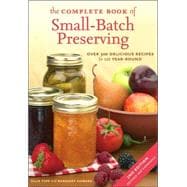
What is included with this book?
Ellie Topp is the author of several cookbooks as well as a professional home economist and consultant to government agencies and industry.
Margaret Howard is a registered dietitian, professional home economist, and food and nutrition consultant. She is the co-author of All Fired Up!
| Introduction | p. 9 |
| Sweet Spreads | |
| Introduction | p. 20 |
| Jams for All Seasons | p. 25 |
| Jelly Made Easy | p. 58 |
| Marvelous Marmalades | p. 74 |
| Conserves, Butters and Curds | p. 92 |
| Light 'n' Low Sugar Spreads | p. 113 |
| Condiments of Choice | |
| Introduction | p. 126 |
| Pickle Perfection | p. 129 |
| Ravishing Relishes | p. 160 |
| Salsa Sensations | p. 179 |
| Choice Chutneys | p. 202 |
| Savory Sauces | p. 220 |
| All Those Extras | |
| Introduction | p. 244 |
| Flavored Oils and Specialty Vinegars | p. 245 |
| The Finishing Touch | p. 264 |
| Fresh From the Freezer | p. 295 |
| Let's Open the Lid and Use What's Inside | p. 332 |
| Index | p. 371 |
| Table of Contents provided by Ingram. All Rights Reserved. |
The New copy of this book will include any supplemental materials advertised. Please check the title of the book to determine if it should include any access cards, study guides, lab manuals, CDs, etc.
The Used, Rental and eBook copies of this book are not guaranteed to include any supplemental materials. Typically, only the book itself is included. This is true even if the title states it includes any access cards, study guides, lab manuals, CDs, etc.